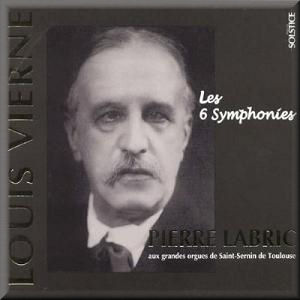 |
 |
|


alternatively
CD: MDT
AmazonUK
AmazonUS
Sound
Samples & Downloads |
Louis VIERNE (1870-1937)
The Organ Works, volume 1: The 6 Symphonies
Symphony no.1, op.14 (1899) [37:06]
Symphony no.2, op.20 (1903) [32:55]
Symphony no.3, op.28 (1911) [29:02]
Symphony no.5, op.47 (1924) [43:36]
Symphony no.4, op.32 (1914) [35:29]
Symphony no.6, op.59 (1930) [42:42]
 Pierre Labric (organ)
Pierre Labric (organ)
rec. Basilica of Saint-Sernin, Toulouse, France, 23-25 November
1970; 11 November 1969 (op.14).
 SOLSTICE SOCD 277-9 [3 CDs: 70:38 + 73:09 + 78:45]
SOLSTICE SOCD 277-9 [3 CDs: 70:38 + 73:09 + 78:45]
|
|
|
Forty-odd years ago, French organist Pierre Labric made these recordings of Louis Vierne's six symphonic masterpieces. In recent years the recordings were found to be on unauthorised sale in the US. It took the intervention of lawyers to have them withdrawn, opening the way, with a much older Pierre Labric's blessing, for French independent Solstice to re-release them in the present boxed set.
The bad news is, the original masters had been lost to time. These recordings were made from the personal LPs of François Carbou, best known as Pierre Cochereau's recording engineer, significantly diminishing the sound quality. These must, therefore, be accepted from the outset as what are partly euphemistically called 'historical' recordings. They certainly are valuable documents, but there is plenty of hiss, occasional minor tracking distortion and vitiated tonal clarity. There are also one or two audible edit joins dotted around, and some, though not all, track ends are faded down prematurely, sometimes killing reverberation stone-dead. These are matters of poor editing rather than poor sound, and can also be found on the most modern DDD recordings.
By way of compensation, however, the French-English booklet notes, recently written by Michel Roubinet, give outstanding detail on the individual works - a paragraph on every movement, of which there are 31 in total! There is also a fine photo of the magnificent Cavaillé-Coll instrument, and further black-and-white images of younger Labric and Vierne in action at the keyboard.
Moreover, the three CDs give 220 minutes of playing time. Not just any old 220 minutes, but nearly four hours of one of France's most stimulating organists - happily still alive at 90 - making premiere recordings of one of the greatest composers for the organ of the 20th century. Vierne's pedigree is second-to-none: pupil of Franck and assistant to Widor and Guilmant at the Paris Conservatory, his own pupils later included Dupré, Nadia Boulanger, Messiaen, Duruflé and Langlais.
No one listening to this endlessly imaginative, dramatic, spell-binding music can fail to be moved by the passion and invention of a man who overcame a whole raft of personal tragedies - reflected in the greater chromaticism and increasingly pungent harmonies of the later Symphonies - to become not just France's national organist in all but name, but a superb, still hideously underrated, composer of all types of music. There is no sonic experience on earth quite like the mind-blowing final three minutes of the Fifth Symphony, but with Labric's help, Vierne comes close on many occasions in these works.
All the Symphonies have five movements, apart from the First, which has six. They are all in a different key, ascending a note each time, and all begin in a minor key, sometimes ending rousingly half an hour later in the major, but just as often in shadow or anger. The Symphonies are unified cyclically in the Franckian style, always harking back to original themes. However much the later Symphonies pushed animatedly against the norms of tonality, Vierne's marvellous sense of structure and narrative, and an irrepressible romantic vitality, ensured that he always held one ear to the great tradition he had inherited from Sweelinck, Bach, Louis Couperin and others.
The CD comes in an attractive foldout 'digipak'-style case, with the booklet sliding in safely under the front over. This is not the only complete set of Vierne's Symphonies: there are at least three more, of which the most recent is reviewed here, with references to the other two. Despite its technical imperfections, this one is certainly a must-hear for all organ fans, and for anyone who likes their music profound, thrilling and loud enough to blow the local church roof off.
Byzantion
Collected reviews and contact at reviews.gramma.co.uk
|
|

